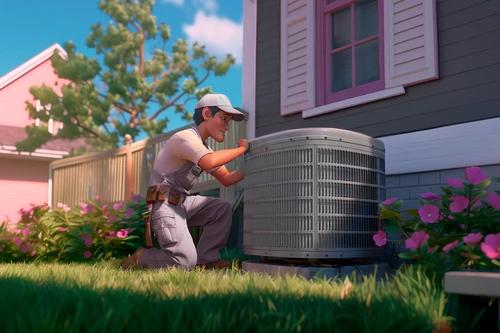The Ultimate AC Buying Guide

Buying a new air conditioner is a big decision. It’s an investment in your home’s comfort, energy efficiency, and long-term savings. With so many options available, though, it can feel a bit overwhelming. To help you make a more confident, informed decision, HVAC.com walks you through everything you need to know before making a purchase, from efficiency ratings to smart features that can make your life easier.
1. Energy Efficiency and SEER2 Ratings
One of the most important factors to consider when buying an air conditioner is energy efficiency. The Seasonal Energy Efficiency Ratio 2 (SEER2) rating tells you how efficiently an AC unit operates throughout a cooling season. The higher the rating, the more energy-efficient the unit, which means lower electricity bills and a smaller carbon footprint.
As of 2023, federal regulations require different SEER2 minimums based on location:
- Northern U.S.: Minimum SEER2 rating of 13.4
- Southern & Southwestern U.S.: Minimum SEER2 rating of 14.3 (since these areas experience hotter temperatures)
These ratings translate to a 14 SEER in the North and a 15 SEER in the South. In January 2023, the SEER2 rating replaced the traditional SEER rating with new testing methods that better reflect real-world conditions, like the impact of ductwork on airflow.
Choosing a unit with a higher SEER2 rating can lead to long-term savings, so it’s worth considering an upgrade if your budget allows.
2. Finding the Right Brand and Price
Not all AC brands are created equal. Choosing a reputable manufacturer ensures better reliability, durability, and performance, with trusted brands leading in innovation and energy efficiency.
Prices vary based on features, size, and efficiency. While premium models offer the best energy savings, advanced technology, quieter operation, and enhanced comfort, there are also budget-friendly brands that provide reliable performance and efficiency without the higher upfront cost. Finding the right balance between the initial cost and long-term savings can help you get the best value for your budget.
3. Choosing the Right Size and Cooling Power
Picking the correct AC size is crucial. A unit that’s too small will struggle to cool your home, while an oversized unit will turn on and off frequently, wasting energy and wearing out faster. Cooling capacity is measured in British Thermal Units (BTUs) per hour, and the right size depends on:
- Square footage of your home
- Climate zone
- Insulation quality
An HVAC professional can perform a load calculation to determine the ideal AC size for your home.
4. Advanced Technology: Variable-Speed and Multi-Speed Units
Today’s air conditioners come with cutting-edge technology to improve efficiency and comfort:
- Variable-speed air conditioners adjust their cooling output based on demand, providing precise temperature control and better humidity management.
- Multi-speed units offer better efficiency than traditional single-speed models but don’t adjust as precisely as variable-speed options.
These advanced features may cost more upfront, but they can lead to significant energy savings, lower utility bills, and improved overall comfort in the long run.
5. Noise Levels: Keeping It Quiet
If you prefer a peaceful home, pay attention to the noise level, measured in decibels (dB).
- A quiet AC typically runs below 60 dB.
- Older or less advanced models may produce more noise.
- Inverter-driven and variable-speed models tend to be the quietest options available.
6. Smart Features and Indoor Air Quality (IAQ) Enhancements
Modern AC units offer extra features that boost convenience and air quality:
- Smart thermostats allow remote control via apps, learning your habits to optimize efficiency and comfort. Pairing your AC with a smart thermostat can help reduce energy waste and lower utility bills while keeping your home at the perfect temperature.
- Indoor air quality (IAQ) products such as UV lights, air purifiers, and humidity control systems can be added to improve air quality, reduce allergens, and maintain optimal humidity levels. These enhancements create a healthier indoor environment, making your home more comfortable and reducing respiratory issues caused by pollutants.
7. Installation and Maintenance: Getting It Right
Even the most efficient AC won’t perform well if it’s installed incorrectly. A professional installation ensures proper sizing, ductwork assessment, and refrigerant charging. Hiring an inexperienced technician can lead to issues like poor airflow, reduced efficiency, and even premature system failure, costing you more in the long run. To keep your system running efficiently for years to come:
- Change filters regularly
- Schedule annual inspections
- Clean outdoor units to prevent airflow blockages
8. Warranty and Customer Support
A good warranty can save you from unexpected repair costs. Look for models with strong manufacturer warranties covering parts and labor. Many brands offer extended warranties when installed by a certified technician, which adds peace of mind.
9. Rebates and Incentives
Many utility companies and manufacturers offer rebates or incentives for purchasing energy-efficient models, which can help offset the upfront cost. Be sure to check for available discounts or government tax credits for energy-efficient purchases, as these can significantly lower your overall investment.
10. Ductwork Considerations
If you’re replacing an old AC, it’s essential to assess the condition of your ductwork, as leaks or blockages can reduce your system's efficiency. Upgrading or repairing ductwork to ensure proper airflow can maximize your new system’s performance and help prevent costly repairs down the road.
